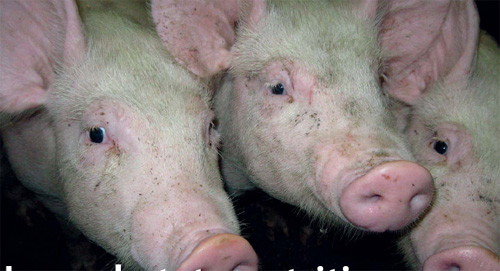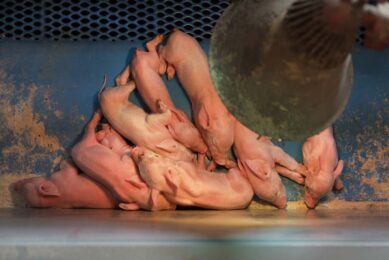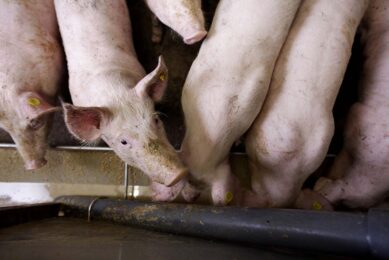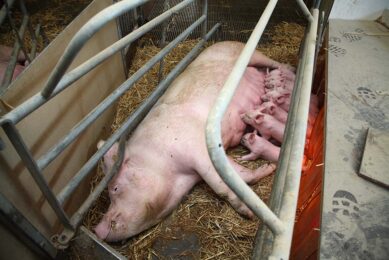Low phytate nutrition – superdosing phytase

Historically, phytases have been used in the monogastric feed sector as an enzyme to break down phytate, releasing phosphorus (P) to the animal that was previously unavailable. In recent years however, the phytase application in feeds has changed to also look at the potential of using high doses of phytase, ‘superdosing’ to remove phytate as an anti-nutrient and produce a ‘low phytate nutrition’ feed programme.
Phytate is the main form of P found in plants and is present at levels between 5 and 50 g/kg which contributes 1.4 to 14g/kg of phytate P. Wheat and rice bran are examples of ingredients high in phytate. Rapeseed and soybean meals normally have higher levels of phytate than cereals. Understanding the phytate levels of raw materials is important in two key ways:
1. To ensure that there is sufficient substrate (i.e. phytate) present in the feed for the phytase to act on in order to meet the P release of a particular phytase.
2. To determine the minimum level of phytate needed to optimise the response in the animal, and what dosage of phytase is required to achieve that level of feed phytate.
Anti-nutrient
It has been known for some time that phytate has been an anti-nutrient in terms of reducing the mineral bioavailability but in recent years there has been research confirming the negative impact that phytate has on amino acid and protein, trace mineral, calcium (Ca), sodium and energy utilisation by the animal. This area is too detailed to cover in this article.
It is thought that phytate, when soluble (low pH), may act as a ‘kosmotrope’ whereby it has the ability to draw a hydration shell around it competing with proteins and other compounds for water. It is therefore likely that the polarity of the protein will determine protein solubility. It is also likely that phytate has the ability to make proteins insoluble; not directly but by changes in water structure, and this can impact not just the proteins found in soybean meal and corn but also other non-vegetable proteins, with casein being an example.
Regardless of the mechanism, the reduced protein solubility results in an increased production of hydrochloric acid (HCl), pepsin, mucin, bile and sodium bicarbonate (NaHCO3) resulting in an increased energy maintenance, endogenous amino acid loss and sodium flow into the lumen with the latter impacting negatively active transport. With the anti-nutrient impact of phytate becoming well documented, the addition of phytases at high levels, ‘superdosing’, to quickly hydrolyse the phytate would be therefore expected to have beneficial effects in terms of amino acids (specifically those associated with mucin and pancreatic secretions such as glycine, serine, threonine and proline) and minerals (zinc, iron, sodium and magnesium). In addition, there are energy benefits both from direct (improved digestibility and solubility of dietary nutrients), indirect (reduced endogenous losses) or net effects whereby energy is utilised for growth rather than maintenance (mucin turnover and enzyme production). The negative impact that phytate can have on pig performance was shown where a synthetic diet devoid of phytate was used for a three week post-weaning trial and compared to the same diet containing 2% phytic acid, higher than the typical swine diet of approximately 1%. The results showed (Figure 1) that the addition of phytic acid reduced average daily gain (ADG) by 77g/day (437 vs 360 g/day) and resulted in a poorer feed conversion ratio (FCR) (1.38 vs 1.81).
Low phytate nutrition
In terms of ‘low phytate nutrition’ it is therefore important to dephosphorylate the phytate as quickly as possible in the proximal gastro-intestinal tract to the lower esters of IP6 such as IP4 and below. The removal of phosphate to achieve the lower moieties will result in a significant decline in IP6 and IP5 levels so reducing the anti-nutrient effect of phytate and producing a ‘low phytate nutrition programme’. With the lower esters IP4 and below being less able to chelate divalent cations, the solubility of such esters will be improved and the natural endogenous phosphatases present in the small intestine will be able to break these down further.
In order to achieve this quick breakdown of phytate it is important to select a phytase that has the key characteristics to achieve this:
• Firstly, that the phytase is non-coated, so that the phytase is immediately effective in the upper acidic region (stomach of the pig) of the gastrointestinal tract where phytate is soluble and can be broken down (Figure 2).
• Secondly, that the phytase has high activity in the acidic region (pig stomach) where phytate is soluble. The general order of phytase activity at pH 3 is modified E.coli (Quantum) > wild type E.coli > Aspergillus > Peniophora when dosed at the same level of FTU/kg in the feed (measured at pH 5.5 AOAC method). This is a key factor as it is the phytase (FTU/kg) activity that is present in the stomach (acidic) region where phytate is soluble rather than what is present in the feed that is important in phytate breakdown. This particular characteristic of the modified E.coli phytase makes it effective in the quick breakdown of phytate.
• Thirdly, that the phytase should have a high affinity for phytate. This is important at typical feed phytate levels found in the market as the phytase still needs to target phytate at low phytate concentrations to ensure that as much feed phytate as possible is broken down. Internal studies have shown that there are differences between phytases with the modified E.coli showing a greater binding affinity for phytate than other phytases.
Superdosing phytase
There have been numerous studies which have looked at very high levels of phytase (at non commercial levels i.e. > 10,000 FTU/kg) in monogastrics. One such swine study by Azain and others from 2004 showed that when a phytase was fed in a P deficient diet at the highest level of phytase supplementation (12,500 FTU/kg), the performance of the animal was significantly better than the positive control (with adequate P) in terms of weight gain and bone ash. In addition, the bone strength of the 12,500 FTU/kg phytase treatment was significantly greater than the positive control which was linked to a significant improvement in bone magnesium. As the response in both gain and bone strength was above that of the positive control it shows that phytase is having other affects apart from P and Ca release and can be attributed to the removal of phytate as an anti-nutrient.
This particular research may indicate an opportunity of using a ‘low phytate nutrition’ programme to improve bone strength for example in breeding gilts and this should be examined further.
Recent studies have shown the improvements that low phytate nutrition can have in the swine starter period. A recent study in swine, three weeks post-weaning, conducted in the UK by Primary Diets studied the interaction of low and high soybean meal at varying levels of phytase (0, 1,250 and 2,500 FTU/kg) in the presence of zinc oxide (3,100 ppm). There was no interaction between the main effects and in terms of phytase, it was shown that the use of increasing levels of phytase significantly improved FCR (Figure 3). In addition, at the highest level of phytase there was a numerical improvement in ADG (+6%). Of additional value was the fact that high levels of phytase significantly reduced the level of post-weaning scour (approximately 70%). The mechanism by which phytase may be beneficial in terms of reduced post-weaning scour is still not yet fully understood, but work by Martinez and others in 2004 suggests a potential mechanism where metallothionien (indication of zinc status) was increased when zinc oxide and phytase were combined. The authors concluded that zinc oxide addition at 1000ppm with phytase (500FTU/kg) gave the same level of metallothionein content as 2000 ppm zinc oxide alone. This may suggest that phytase may breakdown the phytate improving zinc efficacy and opens up the possibility of further work in this area. Indeed it has been suggested in other work that in the presence of phytate the affect of zinc oxide on E.colimay be reduced.
Immediately post-weaning
An additional study in 2011 in the USA looked at the impact that superdosing phytase can have on the performance of pigs immediately post-weaning when fed a low digestible high phytate diet (negative control, NC), compared to pigs fed a high digestible, low phytate diet (positive control, PC). All diets were iso-nutrient and P adequate (exceeded NRC requirements) and contained high levels of zinc oxide (3,100 ppm). In terms of the low digestible diet plasma, fishmeal and whey were reduced and soybean meal increased. Lactose was added to maintain the dietary lactose level.
Phytase was added to the low digestible diet at 1,000, 1,750, 2,500 and 3,250 FTU/kg and pig performance measured. The three week post-weaning results showed that reducing the digestibility of the diet (NC) resulted in a 12% reduction in ADG. There was no effect on FCR. The addition of phytase at the 1,000 FTU/kg to the NC restored the growth performance (Figure 4) of the pigs to 2% above that observed for the PC pigs while in addition, significantly improving the feed conversion by 5% when compared to the NC. Further addition of phytase in this case did not further improve performance beyond that of the 1,000 FTU/kg treatment which may be down to the low level of phytate in the initial diets. The use of 1,000 FTU/kg phytase in the NC reduced feed cost by about $100 in phase 1 and $45 in phase 2 compared to the PC, while maintaining pig performance comparable to PC. This resulted in the NC + 1,000 FTU/kg phytase reducing cost/kg compared to the positive control and improving the overall return per pig.
In terms of using superdosing levels of phytase in swine, the global work (35 comparisons of no phytase vs superdosing) conducted by AB Vista in university and commercial studies have shown that in the nursery (either 21 or 35 days post-weaning) the average response to superdosing was 3.88% in FCR and 6.22% in ADG. More work continues to be conducted in the nursery area and work is ongoing looking at whether this application can be expanded further into the older animal. The future use of phytase will not only revolve around the traditional P and Ca release associated with phytases today but also the use of phytases to remove phytate as an anti-nutrient and the production benefits that may bring.
References available upon request.
Join 18,000+ subscribers
Subscribe to our newsletter to stay updated about all the need-to-know content in the pigsector, three times a week. Beheer
Beheer










 WP Admin
WP Admin  Bewerk bericht
Bewerk bericht